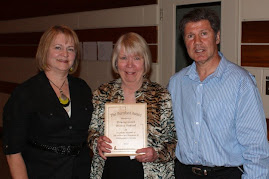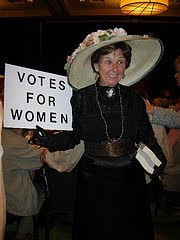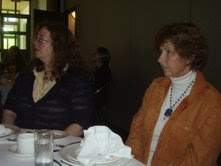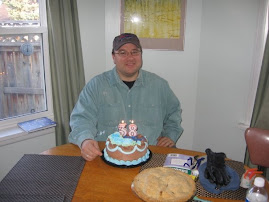Sunday, August 30, 2009
The Narrative Spell at the Sleeping Giant Writers Festival
When I made my workshop picks a month ago, I agonized. What about “Writing the Past,” a memoir workshop with Leilah Nadir? At the festival many people spoke highly of that workshop.
However, I chose Fred Stenson’s presentations on ‘Advanced Fiction," a good choice for me. Fred turned out to be a genial person, friendly and knowledgeable. He focused on the narrative spell, the spell woven by the writer to engage the reader. This is what makes fiction work.
Fred spent some time discussing Point of View (POV). He said he himself had trouble working in third person POV and was much happier in first person until Carol Sheilds told him, “change all your I’s to he’s.” Very often an omniscient POV is brought in to at the beginning of a scene to describe the setting. Sometime the end of a story moves out of the mind of a character into a more universal or omniscient overview as it does at the end of the Joyce story, “The Dead.” Switching POV or using multiple POVs can be done with care, good signalling and a coherent motive. But it's not easy and often publishers are wary of multiple POV’s novels.
Here are a few Stenson pointers.
1. The more the novel mimics our own experience, the more we are engaged.
2. Plots are character driven. The characters move through decision points. If you have writers’ block, you may not know your character well enough. Go back and write a monologue for your character.
3. Plot outlines do not work. Stenson never relies on them. Your character will take on its own life and move away from the outline. You have to let your character go.
4. Readers often cannot say why a book leaves them cold. But one reason is the artificial feeling when the characters are forced to conform to the plot rather than visa versa.
Breaking the Spell. Every time you break the narrative spell, the reader surfaces. She may surface long enough to toss the book across the room. Here are some ways a writer can break the narrative spell.
a. A writer may switch POV without reason or warning. Disconcerting to the reader.
b. We try to write in scenes. But how can you check to make sure you are doing scenes? Check the dialogue. If there is no dialogue, you are not in a scene.
c. Transitions always break the spell but you have to have them to move to the next scene. Keep them short, preferably a word or a phrase.
d. Introspection and long thinks by the characters can be flat spots that cause the reader to disengage. Wordy musings are often unnecessary, especially in the midst of the action. Some writers do not let their characters think at all - Cormac McCarthy for one.
e. Exposition. You need it to get certain facts across to the reader but keep it brief or disguise the info or stagger it in. Dribble in the info. Front loading your story with info is boring.
f. Confusion in the plot. The reader has a right to know where and when the action is taking place, what is going on and who is speaking.
However, I chose Fred Stenson’s presentations on ‘Advanced Fiction," a good choice for me. Fred turned out to be a genial person, friendly and knowledgeable. He focused on the narrative spell, the spell woven by the writer to engage the reader. This is what makes fiction work.
Fred spent some time discussing Point of View (POV). He said he himself had trouble working in third person POV and was much happier in first person until Carol Sheilds told him, “change all your I’s to he’s.” Very often an omniscient POV is brought in to at the beginning of a scene to describe the setting. Sometime the end of a story moves out of the mind of a character into a more universal or omniscient overview as it does at the end of the Joyce story, “The Dead.” Switching POV or using multiple POVs can be done with care, good signalling and a coherent motive. But it's not easy and often publishers are wary of multiple POV’s novels.
Here are a few Stenson pointers.
1. The more the novel mimics our own experience, the more we are engaged.
2. Plots are character driven. The characters move through decision points. If you have writers’ block, you may not know your character well enough. Go back and write a monologue for your character.
3. Plot outlines do not work. Stenson never relies on them. Your character will take on its own life and move away from the outline. You have to let your character go.
4. Readers often cannot say why a book leaves them cold. But one reason is the artificial feeling when the characters are forced to conform to the plot rather than visa versa.
Breaking the Spell. Every time you break the narrative spell, the reader surfaces. She may surface long enough to toss the book across the room. Here are some ways a writer can break the narrative spell.
a. A writer may switch POV without reason or warning. Disconcerting to the reader.
b. We try to write in scenes. But how can you check to make sure you are doing scenes? Check the dialogue. If there is no dialogue, you are not in a scene.
c. Transitions always break the spell but you have to have them to move to the next scene. Keep them short, preferably a word or a phrase.
d. Introspection and long thinks by the characters can be flat spots that cause the reader to disengage. Wordy musings are often unnecessary, especially in the midst of the action. Some writers do not let their characters think at all - Cormac McCarthy for one.
e. Exposition. You need it to get certain facts across to the reader but keep it brief or disguise the info or stagger it in. Dribble in the info. Front loading your story with info is boring.
f. Confusion in the plot. The reader has a right to know where and when the action is taking place, what is going on and who is speaking.
Subscribe to:
Post Comments (Atom)









































































































































































































































































No comments:
Post a Comment